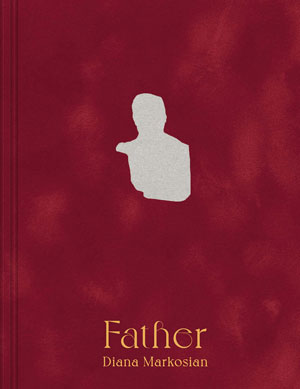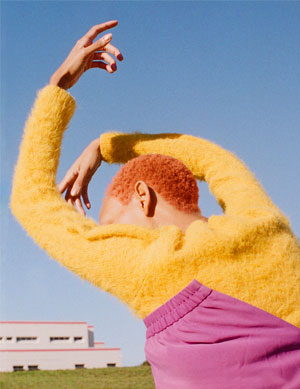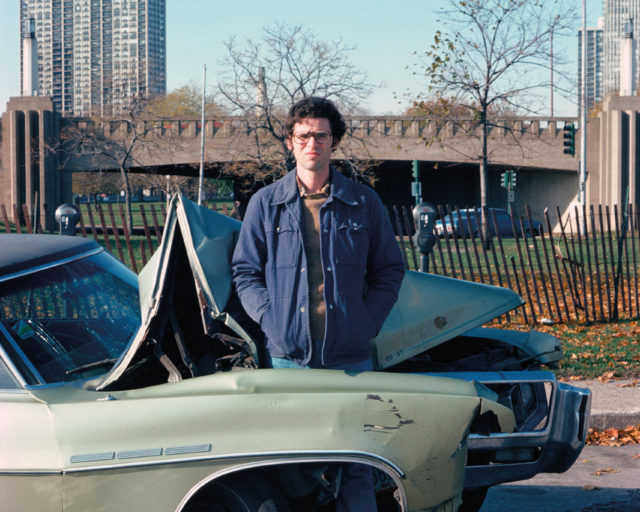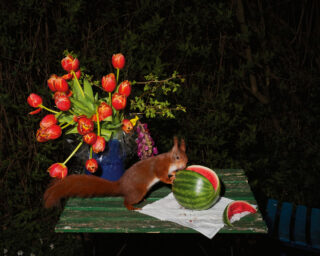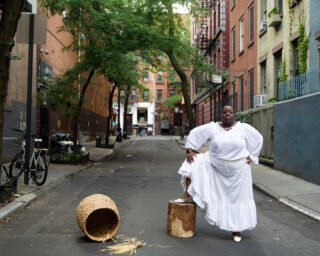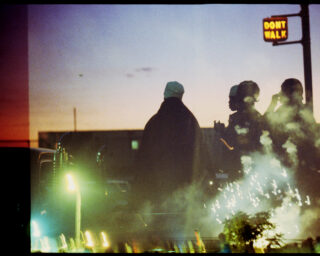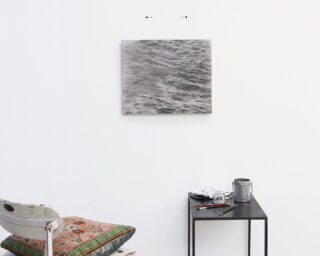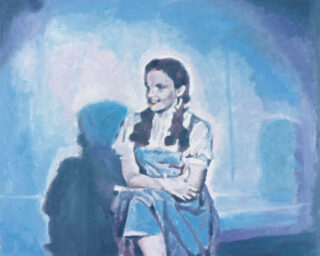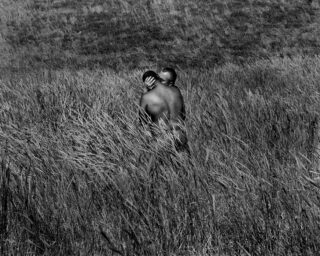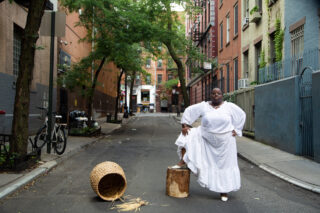Robert Cumming Invents the Photograph
Constructing sets that look functional but are intentionally useless, an artist parodies the seamless illusion of images.
Robert Cumming, Watermelon/Bread,1970
Constructing sets that look functional but are intentionally useless, an artist parodies the seamless illusion of images.
In the early 1970s Robert Cumming spent a lot of time in movie memorabilia shops in Hollywood. These shops—filled with flotsam and jetsam from the classic era of Hollywood cinema—were a curious brand of cultural repository for the young artist from Massachusetts, schooled in the Midwest. Cumming honed in on studio photographs, 8-by-10 black-and white contact prints commissioned in the name of maintaining continuity between scenes, or for testing particular hairstyles or wallpaper samples. The slightly battered stills—bent, inked with notes, and often hole-punched—were nonetheless beautifully photographed, and they had infinitely more detail than the movie-goer ever saw onscreen, as images traveled by at twenty-four frames per second.

Courtesy the artist
Cumming was discovering the curious language of film illusion. A small set light tucked into a corner of an otherwise domestically tepid living room; dolly tracks installed on a wooden platform leading up to a bucolic indoor “marsh” of ferns, grasses, and pine trees surrounding a canoe; a crewmember caught adjusting a fake pine bough on a tripod at the edge of the frame (his ghostlike arm blurred from the long exposure). Cumming wondered: Why in the world did they have to construct that entire marsh for that canoe indoors? That’s some pretty intense work when they could have just gone outside…. The photographs were certainly strange enough to pay attention to, and soon he was buying stacks of them for twenty-five cents apiece. Years later, he would say that it was stills like these that inspired him to dissect the mechanics of photographic perception.
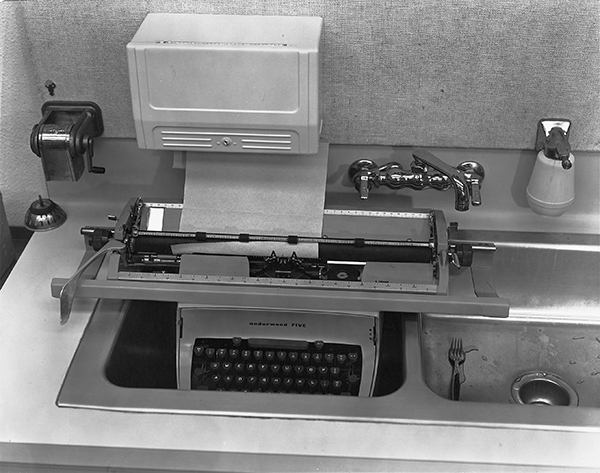
Courtesy the artist
As a painting student in the 1960s, one of Cumming’s influences was Robert Rauschenberg, whose paint on canvas with collage, then photo-silkscreens and three-dimensional Combines, Cumming took as some of the fuel that drove him to study photography and printmaking. Later, as an MFA student at the University of Illinois, Champaign-Urbana, he took courses with photographer Art Sinsabaugh, known for his work with the massive 12-by-20-inch “banquet” camera.
Soon after receiving his master’s degree in 1967, Cumming moved into three dimensions completely, and began by teaching himself a variety of sculptural practices. He made constructions that were functional-looking, but were intentionally useless; they often involved piping, threaded aluminum, hooks, hinges, and grommets on cotton duck, burlap, and canvas. (Few survive, but they look terrific in photographs.) He bought an 8-by-10 view camera in 1968—captivated by the precise detail of the large negative (echoes of Sinsabaugh)—and made use of that unwieldy beast to document his three-dimensional work. Soon enough, he was creating those sculptures for the camera, rather than to exhibit on their own.
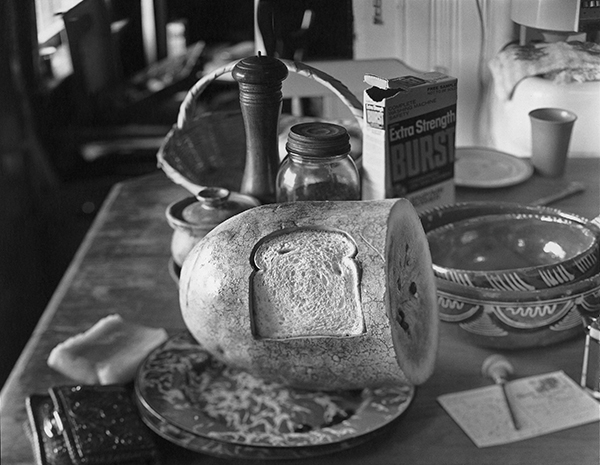
Courtesy the artist
His photographs from the 1970s are a parody of the seamless illusion of film: he leaves subtle “tells” in the frame that reveal his mechanics—intentional mistakes and offscreen tools appear in the image. What unravels lets loose far more absurdity than a set light, paper fern, or plaster rock betrayed in an 8-by-10 studio still. In the diptych Decorator Test (1974), a visual cacophony of stripes covers a corner of wallpaper, floorboards, and steps. A swatch of more pattern is clamped to a tripod—Cumming’s riff on the professional photographer’s test target, used to gauge how accurately a camera depicts reality. Looking closely, however, one sees that this is not reality at all: the “wallpaper” glistens and buckles like plastic-adhesive shelf liner in the upper-left corner; the baseboard is just two flimsy pieces of wood, one wide and one thin, leaning up against the wall. Cumming wanted the viewer to get to know, personally, the process of perception—perhaps to ward off the onset of visual inertia. The pictures unfold slowly over time; the more you look, the more you see.
French philosopher Hubert Damisch mandated in his 1963 essay “Five Notes for a Phenomenology of the Photographic Image” that a true artist should never fall prey to the artificiality of photographic illusion. According to Damisch, photographs were not really “invented” in the early nineteenth century; the camera obscura had existed for centuries, and the lens even longer. It was the desire to fix the image that was new—a latent image was revealed, developed, and preserved; it wasn’t magic: lenses and cameras complied to a spatial system dependent on distance and curvature of glass. Cumming was highly sensitive to these mechanics—for instance, the ability to transform a three-dimensional object with heft and depth into a flat representation. He celebrated this as a skill to be learned and exploited, rather than subverted as opaque—to simultaneously maintain and destroy illusion and quirks of vision with photography.
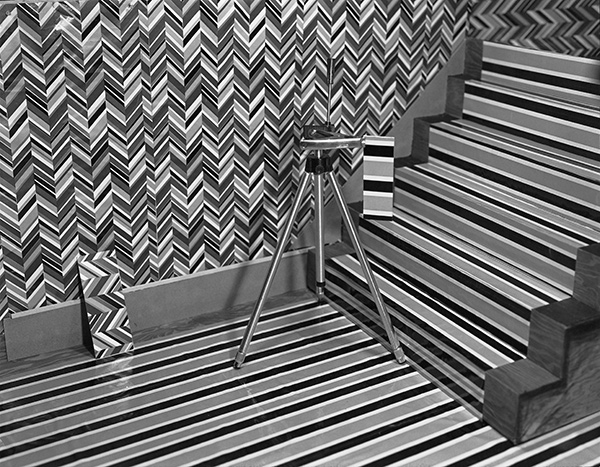
Courtesy the artist
Cumming illustrates what one thinks one sees in a glance when an involuntary imagination ruptures reality: a silhouette of a cactus for a rabbit head, for example (as in Theatre for Two—Easy Analogies, 1978), or paper towels from a dispenser as pages on the platen of a typewriter (Institutional Faucet, 1971).
Cumming’s images undermine the idea that a photograph, upon first glance, is as reliable as anything that reaches the unique receptors leading to our sensorium—eyes, nose, ears, mouth, skin, the liminal areas between the world around us and the world of cognition. He explores the moment of seeing, and delivers us wildly imagined permutations of the moment that follows: when perception is either uncontrollably, automatically processed or mistakenly processed based on remembered experience. But always with a robust and fathomless imagination.
This piece originally appeared in Aperture, issue 211, “Curiosity.”




